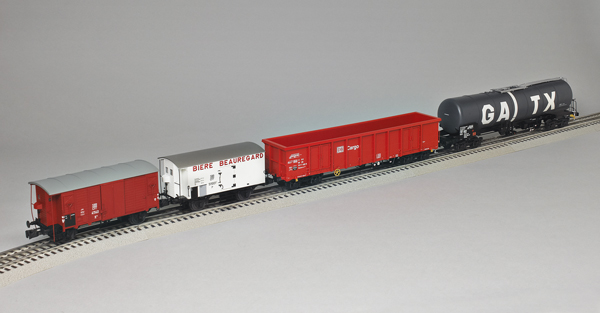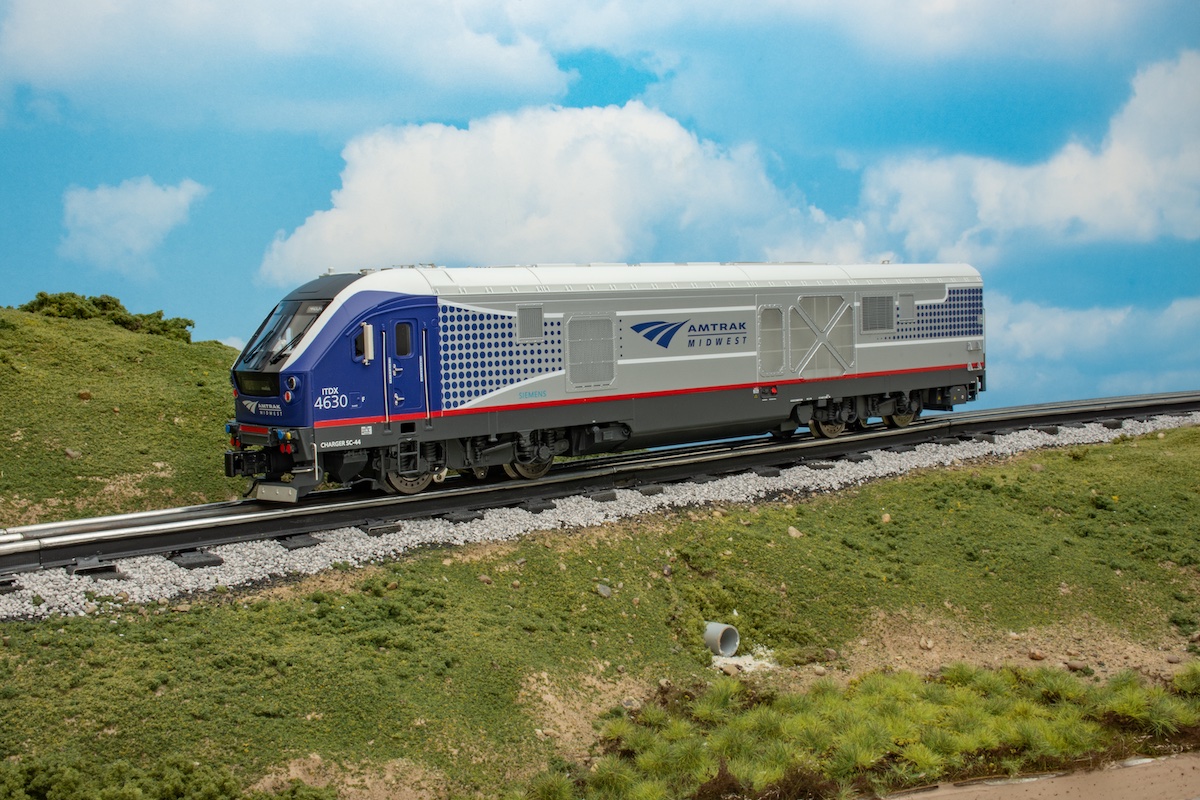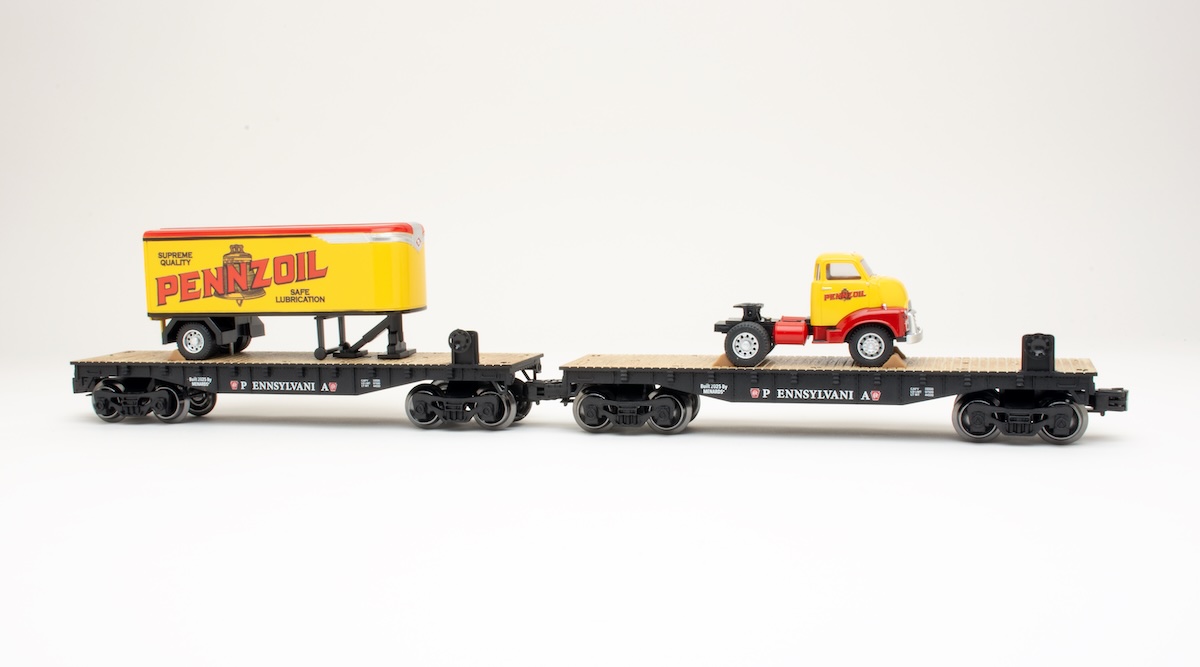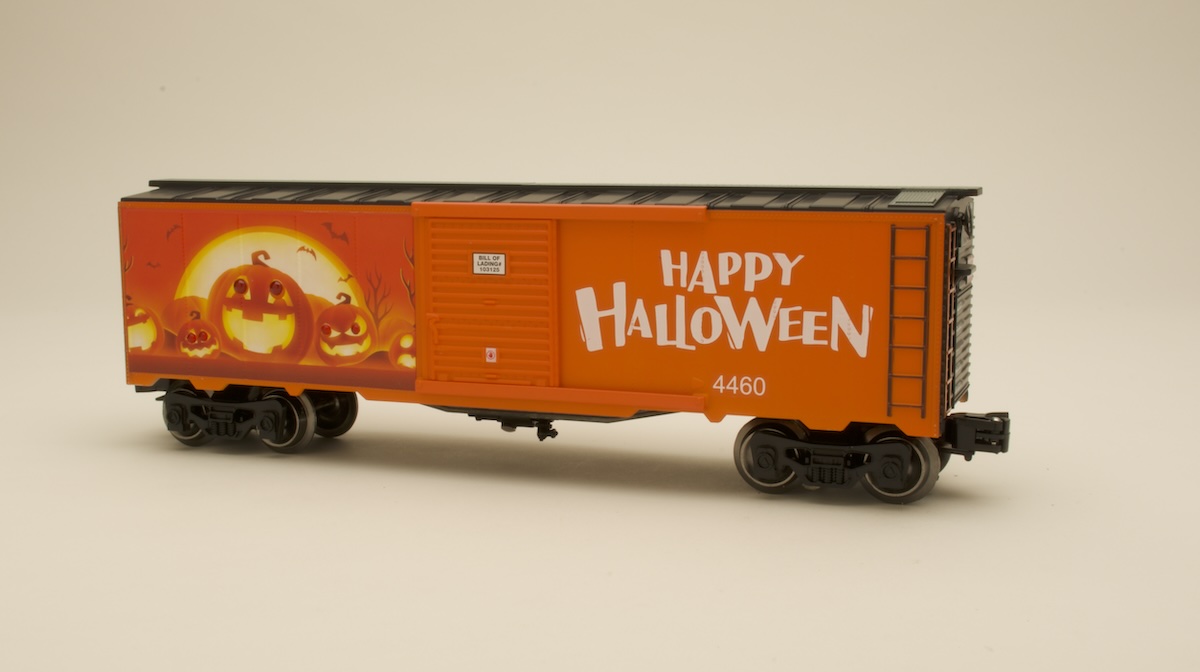So for the record, foreign outline O gauge trains aren’t everyone’s desire. Still, if you want to operate equipment unlike anything already on your pike, MTH’s 1:45 scale products may fill the bill.
No. 20-99018 European modern tank car, $79.95
If you’ve ever waited at a grade crossing as a freight train passed through, you’ve seen a limitless number of tank cars roll by with GATX reporting marks. Well, GATX is the General American Transportation Corp. that, among many other things, leases railroad equipment in North America and Europe.
This tanker is marked for GATX Rail Germany, and it may be the most highly detailed tank car I’ve ever seen.
The first element that pops out is the underside piping. It is pretty darned elaborate, with pipes and connectors for as many as five input or drain lines. You can follow the feeder lines from the valves back up into the tank.
On one side of the pipes there is a large lever marked Auf and Zu (the handle is in the Zu position). On the other side of the pipes there are more levers (two red and one yellow) with white backgrounds to enhance the lever visibility. The pipes and controls are mirrored on both sides of the car, so unlike the gas cap on your car there’s no “wrong” way to park this one at a transfer station.
One end of the car has silver-painted steps and a silver-painted deck, complete with handrails and grab irons.
A brake control is aligned with one side of the handrail. A ladder and handrails curve up the end of the car to a low roofwalk. This is see through, and there are also grab irons along the base of the walk. I imagine this is for a last-chance grab as you tumble down the side of the tank!
Car top details also include what appear to be five hatches that open on the real car, and another access pipe you’d probably need a pneumatic tool to open. A platform surrounds the central hatches.
The other end of the car is far less busy, with a single step on the frame and a matching grab iron. The car has sprung bumpers and die-cast metal trucks. As the photos indicate, trucks differ distinctly from traditional American sideframes. The plastic couplers connect direct to the frame of the car. Because of this, O-54 curves are required.
Of the four cars on hand, this would be the one I’d be tempted to run with American cars. Why? Well, the GATX helps it blend in, and if a visitor questioned it, I’d just say it is a special car made for carrying molten Plutonium!
This is a nice tank car.
No. 20-99025 European modern gondola, $79.95
Deutsche Bundesbahn (the German national railway system) is ready for the long haul with this car. Called an offener guterwagen (an open gondola), this is designed for pretty much any cargo that doesn’t need protection from the weather.
As with the GATX tank car, the undercarriage stands out as a detail high point: You’ll find the two red and one yellow levers with white backgrounds, but this isn’t the same plastic detail piece. Each has a line that crosses the car to mate with a matching lever, and all three lines connect to the base of the car.
There are large yellow wheels on both sides, and you can see an intricate array of brake-line and air-reservoir detailing, too. The car has the same die-cast metal trucks and plastic couplers.
The sides of the car are interesting, reflecting differences in how European and American railways operate.
There are four cast-in doors with latch and hinge detail that will be tall enough for a worker to load cargo into the car direct from a loading dock.
All along the lower side of the car are what look like lift rings, and there are what appears to be cast-on latches, suggesting that other panels may open to dump cargo. There are single steps and grab irons on opposite corners of the car.
The interior has rivet and seam detail on the floor. The sides are undecorated.
As with the tank car, the gondola may not look too much out of place on an American model railroad, though you may want to re-letter it. It can look pretty good assigned to a steel mill train or a mine train or positioned in a scrapyard. Because the couplers are attached to the frame, O-54 curves are required.
No. 20-99009 European boxcar, $69.95
If the previous car was a guterwagen, this baby is called a gedeckter guterwagen. Ergo, a covered gondola. Go figure. Anyway, what I would call a boxcar will be more at home on my O gauge layout with my own small European freight fleet (made by Ace, Darstead, Lima, Skytrex, and Hornby).
The car is a compact 8 inches long and has a mere two axles. Although officially a neutral (SBB – the Swiss Federal Railways), it could easily pass as the target for tonight. The wood-side construction suggests 1930s-50s construction.
The exterior has a lot of detailing you can touch, from the wood-side planks, cast-in air vents, and cast-in (but with add-on supports) hatches on the upper corners of the side. The car has wood floor planking on the interior.
The steel door has nice rivet detail and a grab iron that matches a grab iron on the body of the car. There’s a functional plastic latch to secure the door closed.
There are long steps on the sides of the car, at the doors. I’d hate to think of the labor required to load this rig if you had to step up and into the car to place the cargo.
An interesting curiosity, at least from an American point of view, is the tiny cabin for a brakeman. Back in the early 1990s I was stationed at a U.S. Air Force base in Turkey and saw several Turkish Army ammunition trains roll past – consisting of wood-side boxcars, more than a few with these tiny cabins, and well-armed Turkish soldiers in position.
The end with the cab has cast-in door detailing, windows, side steps, short decks, and even a brake control running up and into a protective covering in the cabin.
The car has plastic couplers attached to the frame, but this requires only O-31 diameter curves.
As with the two previous cars, there is an amazing mix of undercarriage detailing that predominately belongs to the brake and air system. There is an especially intriguing metal shaft with what appears to be a loop for a worker to pull. This extends to both sides of the car. I imagine it is a brake release system since it connects to the air line. The underside of the car has cast-in slats, representing the wood planking of the car floor.
20-99001 European refrigerator car, $69.95
Switzerland is known for banking, Heidi, chocolate, and possibly the largest per capita army in Europe. And the Swiss like their beer, as shown by this Swiss Federal Railways refrigerator car.
The car is painted a nice, sanitary white and is decorated for Biere Beauregard, produced by the Cardinal brewer Founded in 1788 in Fribourg, Switzerland, the brand was acquired by Feldenschlosschen in 1991, so this car has a fairly wide span of time you can utilize it in.
At first glance, it appears similar to the SBB boxcar, but it differs in several important ways. First, and perhaps most obvious, it has a wood door with three hinges and two latches. It is also smaller and suggests cold storage, like for milk or meat. There are two grab irons at the door, one on the door and the other on the body, but they are smaller than those on the boxcar.
There is a guard cabin, with decks, handrails, grab irons, and the brake control – but there are only windows in the end and not on the doors. Just below the cargo doors are two steps, opposed to the boxcar’s single and wider step. On the undercarriage you’ll find the same high level of detail as well as the across-the-body shaft with loops on the end.
As with the other three European cars, the reefer has sprung bumpers, a dummy plastic coupler, and metal wheels. It requires O-31 diameter curves upon which to operate.
The models
These four cars from MTH represent both the modern and near-past worlds of European railroading. The cars are all well made, nicely detailed, and superbly decorated. If I have a boggle, it isn’t so much the non-operating couplers, but rather the couplers being made of plastic. But unless you are exceptionally rough with your trains, this probably won’t matter.
While the target is the European market, this batch of cars suggests there is already a good pool of train gear available if you wanted to start outfitting your own O gauge Euro freight train.
Features: Larger cars O-42 operation, die-cast metal trucks, plastic non-operating couplers














